Translated by Natalia Tsyguleva
Edited by Hierodeacon Samuel (Nedelsky)
The Community of St. Elizabeth in Minsk spiritually ministers to the patients of Europe’s largest hospital for the insane, rehabilitates alcoholics in its metochion, and at the same time earns money by its own independent activity. Our report from Minsk is about this unique Sisterhood, where black and white sisters of charity – nuns and the laywomen – work.
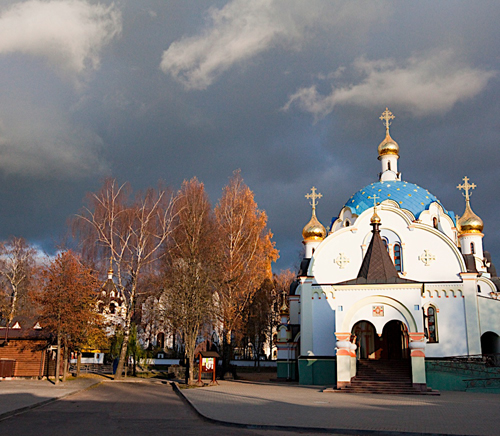 |
| The original project of the hospital chapel adjoins the monastic complex. The Church of the Reigning Icon of the Mother of God |
A Sermon with a Donation Box
Any middle-aged resident of Moscow, who has visited the capital of Belarus, will say that modern Minsk is the Moscow of his childhood. The clean avenues, friendly people, and shops with signs – the grocery, the haberdashery. The difference from Soviet Moscow is only that the golden crosses of the Orthodox churches twinkle among the buildings on Stalin’s times. And the first person who a visitor meets at the Minsk station is an Orthodox Sister of Charity. She stands in a white headscarf with an embroidered golden cross, a skarbonka (donation box) in her hands, a small board under her feet – so as not to freeze on the cold asphalt. The sister collects money for the convent and acts of mercy, accepting money. There are ten “posts” like this in the city, and there are also sixty church shops where the sisters sell monastic goods.
“Of course, the Sisters of Charity are those who first of all who work in the hospitals,” the senior sister, Zinaida Lobosova, tells. “But, after all, we should support them somehow. That is why we also equate with the sisters those who, for the common cause, stand with donation boxes in the street. By the way, they do not just accept money and gifts, they also talk to the people, preach – reminding those who pass by about the Church, answer questions, invite them church. There are known cases when a man in despair was going to commit suicide, but met our sister in his way, and their conversation stopped him.”
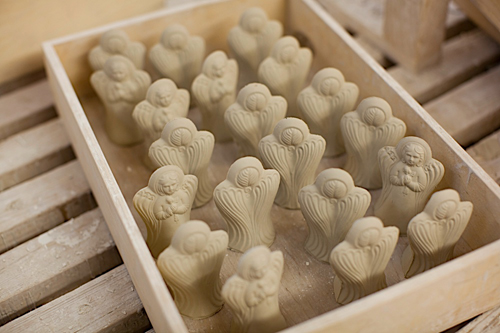 |
| Souvenirs of clay, porcelain, and faience are made in the ceramics workshop of the convent. Any customized ceramic work may be made here |
“First of all those who approach are those who have family concerns,” one of the sisters relates. “A sick child in the family, a son went to prison. Families go through difficult spells now, there are many divorces, lawsuits happen. Once a woman came up to me – she has three sons, and she is suing them for alimony in order to support her. Of course we pray. Standing, I pray the Our Father for somebody, and if one is for some reason in a shop, then one starts praying for those who serve behind the counter.”
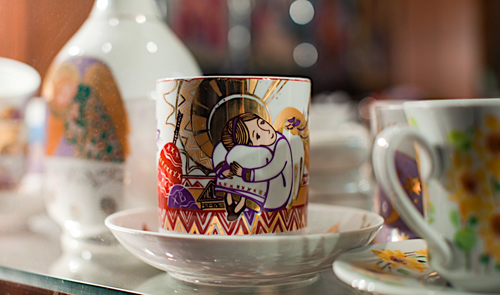 |
| The production of the ceramics workshops is in demand even abroad |
Novinki
The Convent of Holy Elizabeth, for which the sisters collect money, is located on the outskirts of the city, in Novinki. This district is for the residents of Minsk like Kashchenko is for the residents of Moscow. If during conversation you are suddenly told to go for a drive in bus number 18, which has linked the city to Novinki for more then half a century, it means that your sanity is being questioned. The fact of the matter is that Europe’s largest republican hospital for the insane is located in Novinki – 1782 beds, thirty-two treatment sections, a drug abuse department, and a department for anorexia nervosa among them; there is a building where very dangerous criminals, murderers, and repeat offenders are held in custody.
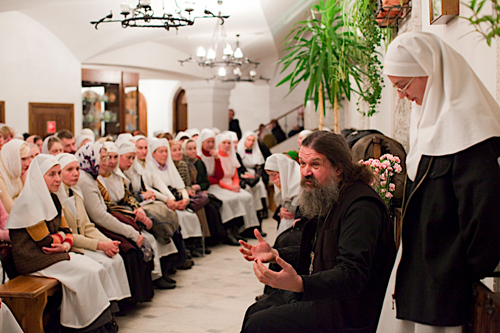 |
| A traditional Sunday meeting of the Sisterhood. Father Andrei Lemeshonok shares his impressions of the past week with the sisters |
Everything began with Novinki. One of the parishioners of the Cathedral of Saints Peter and Paul in Minsk (now Nun Evpraxia), who had worked as a nurse in the hospital, started asking a priest to visit the patients on her own initiative – making her rounds in the wards and talking to the patients, asked if anybody wanted to receive the Mysteries. Soon other young girls joined her. They visited the patients, told them about God, and said their prayers. Thus, in 1994 the Sisterhood was formed, which was named for the Martyr Elizabeth Feodorovna.
“At the beginning we tried to nurse the sick: wash and fed them, clean the wards,” Nun Anfisa (Ostapchuk), one of the first sisters, relates. “But then we understood that there was no need for such work. There was no lack of medical staff – one health-care worker for two patients. But because of our zeal, the nurses just stopped working: ‘Since you came, then work, well and good,’ they said and went into the smoking-room.
The Liturgy in a Hypnotarium
“Vladyka Philaret (Vakhromeev) blessed us to celebrate the Liturgy in the hospital,” the spiritual father of the Sisterhood, Archpriest Andrei Lemeshonok says. “The church had not been built then, and the hypnotarium (a room for performing of hypnosis) was the only suitable place, so we held our first divine service there! It was the day of Exaltation of the Cross in 1996. And at Pascha we were assigned the entrance hall for the divine service. Just imagine, people are going to their relatives, and we are celebrating the Liturgy, receiving the Mysteries in their path, practically in the passage!”
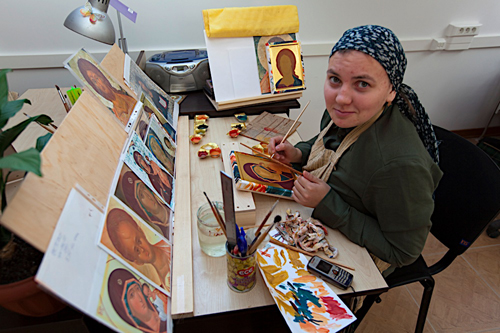 |
| The icon painting studio was organized before the convent’s construction had begun. The first serious professionalism test for the icon-painters was the work on the iconostasis |
The hospital administration encouraged the beginning of the sisters and even offered to build a small hospital chapel. By that time obedience in the hospital and prayer had become the breath of life for some sisters, and they thought about the monastic life.
“I remember, we had a meeting of sisters, and Father Andrew asked those sisters who would like to be tonsured to stand up,” one of the nuns tells. “To my surprise more than ten women stood up! Then they were all young student girls, and now most of them have been tonsured. And even me sinner am a nun, though I did not confess to my wish then.”
“For twenty years Father Nicholas Guryanov from the Zalit Island was my spiritual father,” Father Andrew relates. “Once I came to him together with the sisters. They were wearing white headscarves and sisters’ aprons. When Father Nicholas saw us he said: “Look, the white nuns have come!” That day he blessed us to establish a convent. We said to him: “Father, but we have no money,” and he gave us a piece of money and said: “Here is money, and people will add the rest.” Indeed, people have added up till now. And what we are just building now – we are building a great deal - it is all the same ‘addition.’”
In 1999 the first tonsure took place.
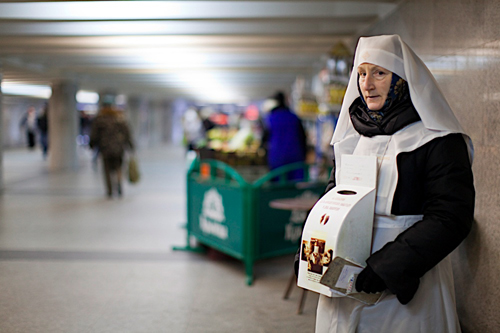 |
| Sisters went into the streets of the city in 1997. Today a sister with a donation box is the first thing one sees getting off a train in Minsk |
“At once we asked ourselves if it was necessary for the nuns – the black sisters – to continue serving the hospital” Nun Tavifa, the rural dean of the convent, relates. “Father Andrew went with this question to Zalit Island, and Father Nicholas answered him: ‘You will be saved by the prayers of the sick.’ That is why the white and black sisters carry their obedience in the hospital together beyond any doubts.”
“The Grand Duchess Elizabeth Feodorovna believed that nuns should not carry out social work. We have another point of view,” Father Andrew says. “A cell seems to be inside a human being. Shall we run away from this world in order to win an inner connection with God? There are many such monasteries. But I do not consider the monastic life in the cell to be the only true way for a monk. It is possible by obedience to deal with the outside world, work. and at the same time to grow spiritually.
“Hello, We are Looking for Talents”
There are eighty black sisters in the community – nuns and lay sisters living in the convent’s territory – and there are about 300 white ones, who live in their own houses, have families, but work in the community – in the hospital or at other obedience. The original project of the hospital chapel grew grew into a whole monastic complex with two wonderful churches, a belfry, a tower, cells, and a refectory.
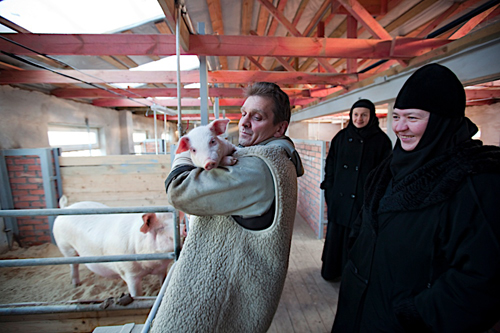 |
| One kolkhoz donated land to the community for housekeeping. This is the metochion of the convent, where people in a difficult life situation can find shelter and undergo rehabilitation. For many of them this is the only chance to get life back to normal |
“We needed money for building,” Father Andrew relates. “I went to a bank and tried to ask. But I couldn’t do it well enough. I had to get ready to earn money with our own hands. Thus, our workshops were created. There are more than twenty today: an icon-painting workshop, a sewing workshop, an icon setting workshop, a ceramics workshop, a stone workshop, a joiner’s workshop, and others. We even have the idea of organizing home workshops for the disabled. Do you remember there was a program ‘Hello, we are looking for talents’? So we are also looking for people capable of laboring and to offer them worthy creative work!”
What is not produced here! Even movies are shot and audio fairy tales are recorded. More than 500 people labour in the workshops. Some of them are former patients of the RCHI who can hardly find work in the city for health reasons. All employees get a salary quite comparable with the salaries of city enterprises. Monastic goods are in great demand all across Belarus.
“When the crisis began, we not only did not discharge the employees, but even took new ones on,” tells Nun Anfisa (Ostapchuk), the senior sister of the house of diligence, where works are located. “This summer fifteen girls were sent to us – they had graduated from Minsk clothing college. And now there is a record in their work-books that they were placed in a job ‘in the monastery.’ It is a great joy for me that the city admits us as a serious enterprise and assigns young professionals to us, but it is also a great responsibility. Not all our employees belong to the Church, many of those who come to the workshops meet with the nuns for the first time. They judge the whole Church by us.”
“A monastery is usually thought of as something quiet, closed, but our sisters go to America, Australia – offering our goods” Father Andrew tells. “The Churches had not been united yet, when we were making a shrine for the Relics of St. John in San-Francisco.”
The sisters take part in exhibitions and organize Orthodox fairs in small towns themselves. They not only sell goods there, but also hold missionary talks, show Orthodox movies, and give concerts (there are two wonderful, professional choirs, such is the custom here – a white one and a black one).
To See God Through Circumstances
“We do not want to depend on sponsors,” Father Andrew says. “Because their intensions can change for some reason or other. What are we supposed to do then? But selling our goods we can develop further. Now there are five sisters in one cell. It is very difficult psychologically; that is why we have to build more. But we need money for it. Some condemn us, saying that a monastery should not be like that. But how do I know what it should be like? God made it like that. Shall we argue with God? One can not restrict God to our intelligence, our vision.
“Once a monk from the St. Panteleimon’s Monastery on the Holy Mount Athos, Father Kirion, came to us,” Nun Tavifa, the rural dean of the convent tells. “He said that social service is very important for a monk, because modern people tend to be unsociable, hardhearted, but contacts with the help for the sick not to retreat into oneself. Generally, the Sisterhood does not have any clear plan; life itself dictates how we should develop. Our entity is complex, someone from the outside can not understand it at once. But this entity is not artificial – it just happened this way. It is important to see God through circumstances. He sends us such conditions that enable our convent and Sisterhood to develop.”
“God enables us to do what we do,” Father Andrew says. “And we have to not waste this time, because we do not know what will happen tomorrow. I expect nothing will be easy. It is impossible to live always on a high level. Quantity has to be transformed into quality. And quality is possible if persecutions begin, in my opinion. When in 1987 I came to the church, the quality of people’s faith was quite another, because then one had to endure a great deal to be a believer.”
The Brethren
“It used to be this way. A man from prison comes to the monastery and says ‘Feed me!’ and – we feed. Then he asks for money – we give him some. But he will immediately spend it on drink! The idea to organize a settlement started up,” Father Andrew relates.
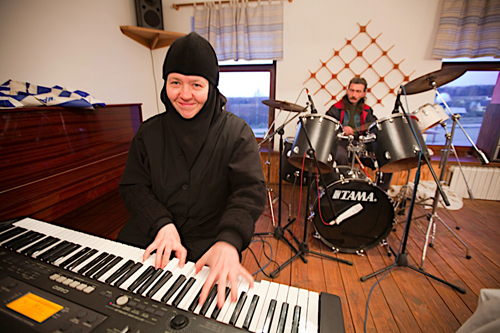 |
| The metochion has its own band. Nun Irina (Denisova), the conductor, practices music with the brethren |
In 2000, one kolkhoz donated land to the community thirty kilometers from the convent, in Bald Mountain village. It had not been ploughed for ten years; it was just clay and stones. There was also a dilapidated cowshed where accommodation was arranged. Two fragile nuns – “mothers superior of the metochion” – settled in the attic of the cowshed.
“The brothers’ obedience probably will always be a riddle, a miracle both for me and for the other sisters,” Nun Thamar says, who directed the metochion for three years. “But anything could happen here – murders, arsons, and skirmishes between inhabitants. This is no joke – a hundred alcoholics, drug addicts, murderers, and only two nuns to control them? We are still scared. But nothing bad has happened, by God’s grace.”
The brothers take part in building, work in the cowshed, in the garden, in the piggery, and assist in the kennel of the central Asian sheepdogs. All employees are paid a small salary for work. Though there are those who do not conceal their intention of passing the winter at somebody else’s expense.
Recently a new cottage, a refectory, and a church had been completed. Once a week at the Liturgy there is Confession and Communion, and a general meeting and a talk with the spiritual father takes place. The brothers incessantly read the Psalter by turn. And at the end of the day, in all weathers the inhabitants make a sacred procession around the metochion, saying the Jesus Prayer by turn, and then ask for each others’ forgiveness, as on Forgiveness Sunday.
An important condition of living in the metochion is abstinence from alcohol and drugs. At first the spiritual “therapy” was of little service: if one of the wards failed and began drinking, then very soon the majority of inhabitants of the metochion drank.
“Of course, failures happen; anything may happen,” Father Andrew admits. “One can not expect that people who spent their lives drinking or being behind bars will suddenly reform and start creative work. They will fall, will fail. The most terrible and painful thing for me is when there is suspiciousness and mistrust in my heart to those who lie again and again. But do we not do the same – come to repent, but then fall again and again? God forgive us, so do we.”
In the Ambulatory
Every Sunday, after the moleben to the Martyr Elizabeth, all the sisters gather for spiritual talks in the ambulatory of the convent. The meeting lasts about three hours. Black and white sisters, the deacons and priests – all equal to one other - step up if they wish and tell what has happened during the week, what they have been thinking of, ask for prayer for somebody or to pay a visit to a sick person.
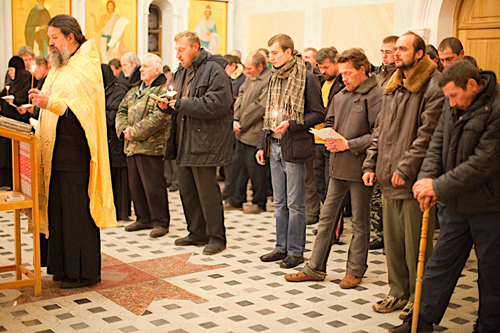 |
| The number of the convent’s inhabitants ranges between fifty and eighty brothers. Divine services are held regularly here. Day and night brothers incessantly read the Psalter |
“I want to read you a parable, which amazed me and which I have been thinking of this week,” one of the white sisters began. “Once upon a time there was a little bird. She wanted to become devout and decided to that end to pick her favorite forest berries and present them to somebody. She brought them to a horse, but the horse ate them and died. The moral of this parable is as follows: thank God, nobody has died from my sham devoutness yet. Forgive me, sisters!”
Outsiders are not allowed into the sisters’ meetings. The sisters share with each other their inner worries, for which an atmosphere of trust is needed.
“At the beginning we listened to the talks of Father Sophrony (Sakharov),” Father Andrew relates. “Just listened, because it is very difficult to begin at once a dialogue in which the sisters would believe one other, confide to one another. But it is important, because we are tied up together, we depend on one other. We have to know that we will be understood, supported, and not laughed at. A good monastery is a family where people love, trust, help, and feel compassion for one other. There must be integrity in the family; there is no family without integrity. This is how matters stand in the monastery. A stranger comes and he has to adhere to the family. It does not happen at once. But this is probably the way of our whole life – to see God through our neighbor and to accept His will.”

